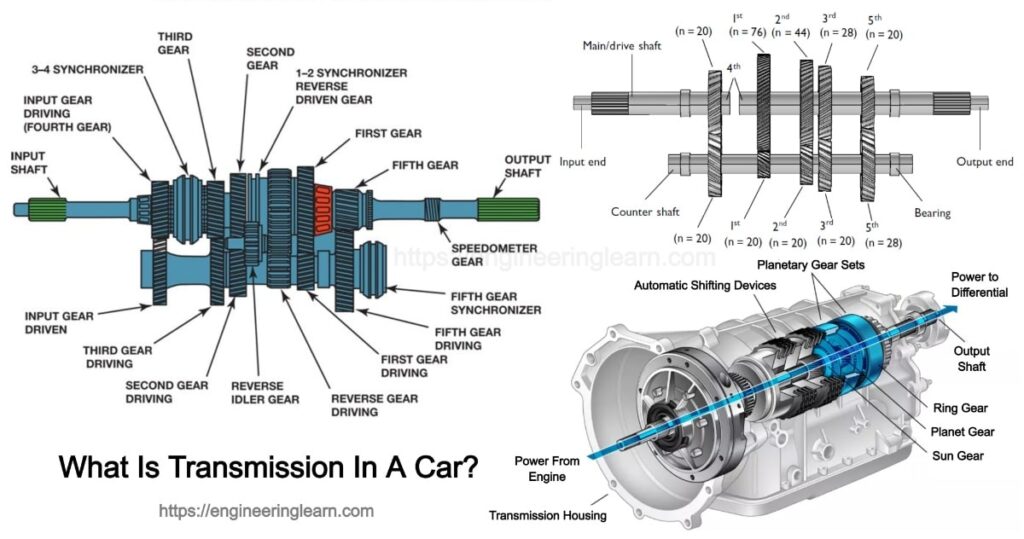What Is Transmission On A Car

Let's talk about transmissions. This isn't just about knowing where to put the key and go; this is about understanding the heart of your vehicle's drivetrain. Whether you're planning a transmission flush, diagnosing a shifting problem, or even considering a performance upgrade, a solid grasp of transmission fundamentals is essential. This article will break down the workings of a typical automotive transmission, explain its components, and provide some basic troubleshooting tips. Consider this your deep dive into the gearbox that powers your ride.
Why Understanding Your Transmission Matters
Why bother learning about your transmission? Here's why it's important:
- Informed Maintenance: Knowing how your transmission works empowers you to perform preventative maintenance effectively, potentially avoiding costly repairs down the line.
- Accurate Diagnosis: When your car isn't shifting smoothly, understanding the system allows you to pinpoint the issue, whether it's a sensor, fluid problem, or something more significant.
- Smart Modifications: If you're considering performance upgrades, understanding the transmission's limitations and capabilities is crucial for selecting compatible parts and avoiding damage.
- Cost Savings: Being able to diagnose and potentially fix minor transmission issues yourself can save you a considerable amount of money on labor costs.
Key Specs and Main Parts
The transmission's primary job is to multiply engine torque and deliver it to the wheels at the appropriate speed. Let's explore the main components that make this happen:
Manual Transmissions:
- Input Shaft: Driven directly by the engine's clutch.
- Output Shaft: Delivers power to the driveshaft or transaxle.
- Gears: Sets of gears with varying sizes and ratios, providing different levels of torque multiplication and speed.
- Synchronizers (Synchros): Mechanisms that equalize the speeds of the gears before they engage, preventing grinding.
- Shift Forks: Move the synchronizers to engage the desired gear.
- Shift Linkage: Connects the shift lever in the cabin to the shift forks in the transmission.
- Countershaft (or Lay Shaft): An intermediate shaft that carries gears and transfers power between the input and output shafts.
Automatic Transmissions:
- Torque Converter: A fluid coupling that replaces the clutch in a manual transmission, allowing the engine to run even when the vehicle is stopped.
- Planetary Gear Sets: Complex gear systems that provide multiple gear ratios.
- Clutches and Bands: Hydraulically operated components that engage and disengage different parts of the planetary gear sets to change gear ratios.
- Valve Body: A hydraulic control center that directs fluid pressure to the clutches and bands, controlled by the transmission control module (TCM).
- Transmission Control Module (TCM): An electronic control unit that monitors various sensors and controls the shifting process.
- Transmission Fluid Pump: Creates the hydraulic pressure needed to operate the clutches, bands, and valve body.
How It Works
Manual Transmission Operation:
When you depress the clutch pedal, you disconnect the engine from the transmission. Moving the shift lever selects a gear, which engages a specific pair of gears on the input and output shafts via the synchronizers and shift forks. The engine's power flows through the input shaft, through the selected gear pair, and then out through the output shaft to the wheels. Different gear ratios provide different levels of torque multiplication and speed. Lower gears provide more torque for acceleration, while higher gears provide better fuel economy at cruising speeds.
Automatic Transmission Operation:
The torque converter allows the engine to spin independently of the transmission's input shaft. As engine speed increases, the torque converter transfers more power to the transmission. The TCM monitors various sensors, such as vehicle speed, engine speed, and throttle position, to determine the optimal gear. It then signals the valve body to direct hydraulic pressure to the appropriate clutches and bands, engaging the selected gear ratio within the planetary gear sets. This process happens seamlessly, without the need for manual clutch operation.
Real-World Use - Basic Troubleshooting
Here are some common transmission issues and potential causes:
- Slipping Gears (Automatic): Could indicate low transmission fluid, worn clutches, or a faulty valve body.
- Rough Shifting (Automatic): Might be caused by dirty transmission fluid, a faulty solenoid in the valve body, or a failing TCM.
- Grinding Gears (Manual): Often indicates worn synchronizers or improper clutch adjustment.
- Difficulty Shifting (Manual): Could be caused by a worn clutch, damaged shift linkage, or low transmission fluid (in some cases).
- Fluid Leaks: Common culprits include worn seals, damaged gaskets, or cracks in the transmission case. The color and smell of the fluid can also provide clues; burnt smelling fluid indicates overheating and possible internal damage.
Important Note: Before attempting any transmission repair, consult your vehicle's service manual. It provides detailed instructions, torque specifications, and safety precautions.
Safety - Risky Components
Working on a transmission can be dangerous due to the following:
- High Temperatures: Transmission fluid can be extremely hot, especially after the vehicle has been running. Allow the transmission to cool completely before working on it.
- Heavy Components: Transmissions are heavy and awkward to handle. Use proper lifting equipment and techniques to avoid injury.
- Springs and Retainers: Internal transmission components, such as springs and retainers, can be under significant tension and may unexpectedly release, causing injury. Wear safety glasses and use appropriate tools to compress and release these components safely.
- Hydraulic Pressure: Automatic transmissions operate under high hydraulic pressure. Never disconnect hydraulic lines or components while the engine is running or the system is pressurized.
Always disconnect the battery before working on any electrical components of the transmission, such as sensors or the TCM.
